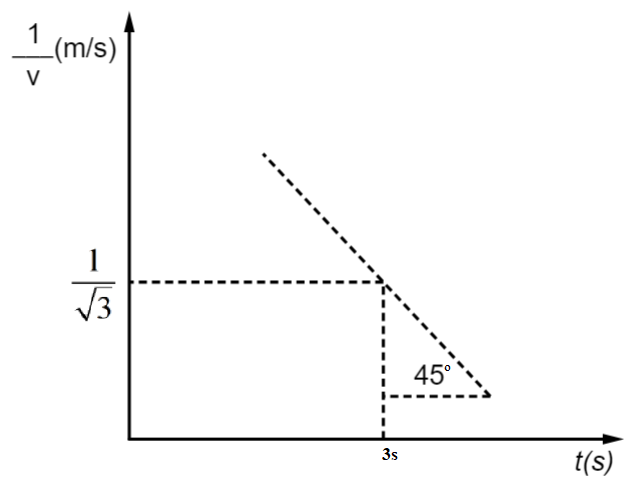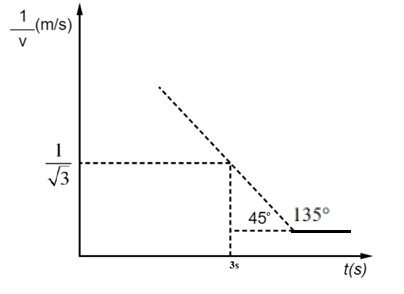
The diagram shows the variation of $\dfrac{1}{v}$ (where $v$ is the velocity of the particle) with respect to time. At time $t=3\ \text{s}$ using the details given in the graph, the instantaneous acceleration will be equal to


Answer
556.8k+ views
Hint: The instantaneous acceleration of a body at any instant is defined as the time derivative of the velocity of the particle at that instant. This can be mathematically written as $a=\dfrac{\text{d}v}{\text{d}t}$
Also, the slope of a curve is given as,
$m=\dfrac{\text{d}y}{\text{d}x}=\tan \theta $
Formula used:
$a=\dfrac{\text{d}v}{\text{d}t}$
Complete step by step answer:
Consider the velocity of a particle is defined as a function of time. This can be denoted as $v\left( t \right)$. The velocity function can be used to determine the velocity of the particle at any instant.
Now, instantaneous acceleration is defined as the rate of change of velocity with respect to time at any instant. This can be mathematically written as,
$a=\dfrac{\text{d}v}{\text{d}t}$
Now, the graph shows the variation of $\dfrac{1}{v}$ with respect to time. The slope of the graph can be calculated as,
$\begin{align}
& m=\dfrac{\text{d}\left( \dfrac{1}{v} \right)}{\text{dt}} \\
& =-\left( \dfrac{1}{{{v}^{2}}} \right)\dfrac{\text{d}v}{\text{d}t}
\end{align}$
Now, the slope is also given as the tangent of the angle made by the curve at any instant. The angle is measured between tangent to the curve and positive x-axis.
Thus,

$\begin{align}
& m=\tan \theta \\
& =\tan \left( 180{}^\circ -45{}^\circ \right) \\
& =\tan \left( 135{}^\circ \right) \\
& =-1
\end{align}$
From, the two obtained equations,
$\begin{align}
& \tan \theta =-\left( \dfrac{1}{{{v}^{2}}} \right)\dfrac{\text{d}v}{\text{d}t} \\
& -1=-\left( \dfrac{1}{{{v}^{2}}} \right)\dfrac{\text{d}v}{\text{d}t}
\end{align}$
The aim is to find the instantaneous acceleration at $t=3\ \text{s}$. Therefore, determine the value of $\dfrac{1}{v}$ at $t=3\ \text{s}$. The graphs show ${{\left( \dfrac{1}{v} \right)}_{t=3}}=\dfrac{1}{\sqrt{3}}$. Use this value in the above obtained expression. The instantaneous acceleration is calculated as,
$\begin{align}
& -1=-\left( \dfrac{1}{{{v}^{2}}} \right)\dfrac{\text{d}v}{\text{d}t} \\
& -1=-{{\left( \dfrac{1}{\sqrt{3}} \right)}^{2}}\dfrac{\text{d}v}{\text{d}t} \\
& \dfrac{\text{d}v}{\text{d}t}={{\left( \sqrt{3} \right)}^{2}} \\
& =3\ \text{m}\cdot {{\text{s}}^{-2}}
\end{align}$
Thus, the value of instantaneous acceleration at $t=3\ \text{s}$ is $3\ \text{m}\cdot {{\text{s}}^{-2}}$.
Note: Use the rules of differentiation carefully while calculating the instantaneous acceleration. Determine the value of $\dfrac{1}{v}$ at the instant when the instantaneous acceleration is to be determined. The angle to be used to calculate the slope must be the angle between tangent and positive x-axis.
Also, the slope of a curve is given as,
$m=\dfrac{\text{d}y}{\text{d}x}=\tan \theta $
Formula used:
$a=\dfrac{\text{d}v}{\text{d}t}$
Complete step by step answer:
Consider the velocity of a particle is defined as a function of time. This can be denoted as $v\left( t \right)$. The velocity function can be used to determine the velocity of the particle at any instant.
Now, instantaneous acceleration is defined as the rate of change of velocity with respect to time at any instant. This can be mathematically written as,
$a=\dfrac{\text{d}v}{\text{d}t}$
Now, the graph shows the variation of $\dfrac{1}{v}$ with respect to time. The slope of the graph can be calculated as,
$\begin{align}
& m=\dfrac{\text{d}\left( \dfrac{1}{v} \right)}{\text{dt}} \\
& =-\left( \dfrac{1}{{{v}^{2}}} \right)\dfrac{\text{d}v}{\text{d}t}
\end{align}$
Now, the slope is also given as the tangent of the angle made by the curve at any instant. The angle is measured between tangent to the curve and positive x-axis.
Thus,

$\begin{align}
& m=\tan \theta \\
& =\tan \left( 180{}^\circ -45{}^\circ \right) \\
& =\tan \left( 135{}^\circ \right) \\
& =-1
\end{align}$
From, the two obtained equations,
$\begin{align}
& \tan \theta =-\left( \dfrac{1}{{{v}^{2}}} \right)\dfrac{\text{d}v}{\text{d}t} \\
& -1=-\left( \dfrac{1}{{{v}^{2}}} \right)\dfrac{\text{d}v}{\text{d}t}
\end{align}$
The aim is to find the instantaneous acceleration at $t=3\ \text{s}$. Therefore, determine the value of $\dfrac{1}{v}$ at $t=3\ \text{s}$. The graphs show ${{\left( \dfrac{1}{v} \right)}_{t=3}}=\dfrac{1}{\sqrt{3}}$. Use this value in the above obtained expression. The instantaneous acceleration is calculated as,
$\begin{align}
& -1=-\left( \dfrac{1}{{{v}^{2}}} \right)\dfrac{\text{d}v}{\text{d}t} \\
& -1=-{{\left( \dfrac{1}{\sqrt{3}} \right)}^{2}}\dfrac{\text{d}v}{\text{d}t} \\
& \dfrac{\text{d}v}{\text{d}t}={{\left( \sqrt{3} \right)}^{2}} \\
& =3\ \text{m}\cdot {{\text{s}}^{-2}}
\end{align}$
Thus, the value of instantaneous acceleration at $t=3\ \text{s}$ is $3\ \text{m}\cdot {{\text{s}}^{-2}}$.
Note: Use the rules of differentiation carefully while calculating the instantaneous acceleration. Determine the value of $\dfrac{1}{v}$ at the instant when the instantaneous acceleration is to be determined. The angle to be used to calculate the slope must be the angle between tangent and positive x-axis.
Recently Updated Pages
Master Class 12 Economics: Engaging Questions & Answers for Success

Master Class 12 Maths: Engaging Questions & Answers for Success

Master Class 12 Biology: Engaging Questions & Answers for Success

Master Class 12 Physics: Engaging Questions & Answers for Success

Master Class 8 Maths: Engaging Questions & Answers for Success

Class 8 Question and Answer - Your Ultimate Solutions Guide

Trending doubts
What is meant by exothermic and endothermic reactions class 11 chemistry CBSE

10 examples of friction in our daily life

One Metric ton is equal to kg A 10000 B 1000 C 100 class 11 physics CBSE

1 Quintal is equal to a 110 kg b 10 kg c 100kg d 1000 class 11 physics CBSE

Difference Between Prokaryotic Cells and Eukaryotic Cells

What are Quantum numbers Explain the quantum number class 11 chemistry CBSE




